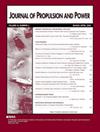Analysis on Propulsive Performance of Hollow Rotating Detonation Engine with Laval Nozzle
IF 2.4
4区 工程技术
Q2 ENGINEERING, AEROSPACE
引用次数: 0
Abstract
In the present study, an experimental performance analysis of hollow rotating detonation engines (RDEs) with Laval nozzles is carried out for the first time. Experiments of a hollow rotating detonation engine with a Laval nozzle were performed with a modular RDE at a backpressure condition of 1 atm. Two configurations with area ratios of the outlet throat to the inlet of [Formula: see text] and 2.7 have been tested with gaseous methane/oxygen as propellants. Three normalized metrics, usually used for evaluating the performance of conventional rocket engines, are introduced to analyze the performance deficit between the measured value of an RDE and the ideal value of an isobaric-combustion-based engine. These metrics allow for assessing the entire engine and each component separately. The metric analysis suggests a small outlet-to-inlet area ratio ([Formula: see text]) is detrimental to the propulsive performance. To explain the mechanism, a gas-stratification flowfield model is further proposed. It is found that the unchoked region in the combustible gas layer, which is caused by unchoked injection on the injecting plate, is responsible for the performance deficit of the combustion chamber. This model is then validated by one-dimensional numerical simulations and experimental data. In addition, we also focus on the global performance, including the gross thrust, the specific impulse, and the utilization of the supplied stagnation pressure. The result implies a tradeoff space when choosing an appropriate [Formula: see text].拉瓦尔喷管空心旋转爆震发动机推进性能分析
在本研究中,首次对带有拉瓦尔喷嘴的空心旋转爆震发动机(RDE)进行了实验性能分析。在1个大气压的背压条件下,用模块化RDE对带有拉瓦尔喷嘴的空心旋转爆震发动机进行了实验。已经用气态甲烷/氧气作为推进剂对[公式:见正文]和2.7的出口喉部与入口面积比的两种配置进行了测试。介绍了三种常用于评估常规火箭发动机性能的标准化指标,以分析等压燃烧发动机RDE测量值与理想值之间的性能缺陷。这些指标允许单独评估整个发动机和每个部件。度量分析表明,较小的出入口面积比([公式:见正文])对推进性能不利。为了解释其机理,进一步提出了气体分层流场模型。研究发现,由喷射板上的未堵塞喷射引起的可燃气体层中的未堵塞区域是燃烧室性能缺陷的原因。然后通过一维数值模拟和实验数据对该模型进行了验证。此外,我们还关注全球性能,包括总推力、比冲和供应停滞压力的利用率。当选择合适的[公式:见正文]时,结果意味着一个折衷空间。
本文章由计算机程序翻译,如有差异,请以英文原文为准。
求助全文
约1分钟内获得全文
求助全文
来源期刊

Journal of Propulsion and Power
工程技术-工程:宇航
CiteScore
4.20
自引率
21.10%
发文量
97
审稿时长
6.5 months
期刊介绍:
This Journal is devoted to the advancement of the science and technology of aerospace propulsion and power through the dissemination of original archival papers contributing to advancements in airbreathing, electric, and advanced propulsion; solid and liquid rockets; fuels and propellants; power generation and conversion for aerospace vehicles; and the application of aerospace science and technology to terrestrial energy devices and systems. It is intended to provide readers of the Journal, with primary interests in propulsion and power, access to papers spanning the range from research through development to applications. Papers in these disciplines and the sciences of combustion, fluid mechanics, and solid mechanics as directly related to propulsion and power are solicited.
 求助内容:
求助内容: 应助结果提醒方式:
应助结果提醒方式:


